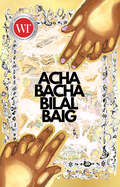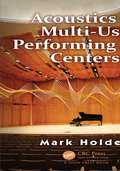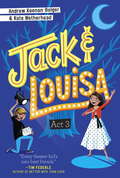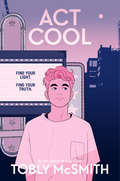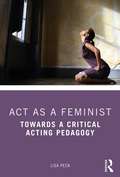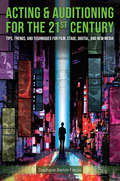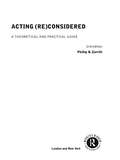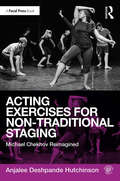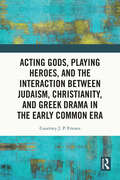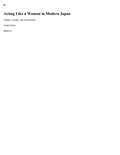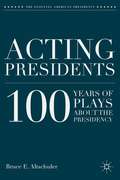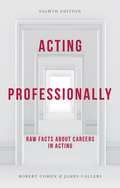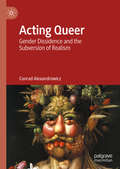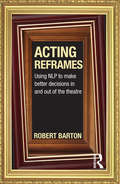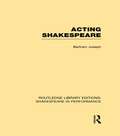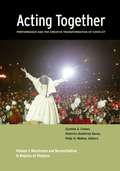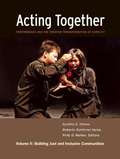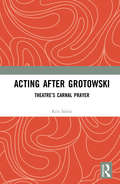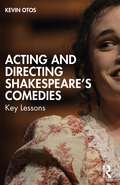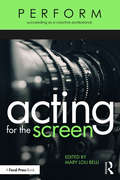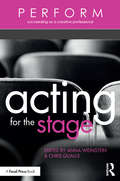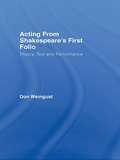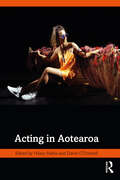- Table View
- List View
Acha Bacha
by Bilal BaigFor years, Zaya has delicately balanced his relationship with his Muslim faith and queer identity by keeping his genderqueer lover and manipulative mother apart. But when his mother ends up in the hospital on the same day his partner is leaving for pilgrimage, Zaya’s worlds come crashing in on each other, opening a space for traumatic memories to resurface. Acha Bacha boldly explores the intersections between queerness, gender identity and Islamic culture in the Pakistani diaspora. It’s about the way we love, the way we are loved and what it takes to truly accept love.
Acoustic Interculturalism
by Marcus Cheng Chye TanAcoustic Interculturalism is a study of the soundscapes of intercultural performance through the examination of sound's performativity. Employing an interdisciplinary approach, the book examines an akoumenological reception of sound to postulate the need for an acoustic knowing - an awareness of how sound shapes the intercultural experience.
Acoustics of Multi-Use Performing Arts Centers
by Mark HoldenMulti-use performing arts centers are among the most complex of all building types and require excellent and flexible acoustics in order to suit the facility's varied programming needs. This technical and practical book by renowned acoustician Mark Holden delivers a full discussion of the challenges and solutions that arise in the concept, design, construction and commissioning phases. It serves students, architects, engineers, designers and acousticians.
Act 3
by Kate Wetherhead Andrew Keenan-Bolger Ben KirchnerA show-stopping middle-grade series about life in and out of the spotlight from Broadway stars and Internet sensations Andrew Keenan-Bolger and Kate Wetherhead.Two weeks at Camp Curtain-Up is just what Jack and Louisa need to fuel their passion for theater: Broadway musical sing-alongs, outdoor rehearsals, and tons of new MTNs (musical theater nerds) to meet... maybe even a special someone. It almost feels like fate when the two friends return home to find local auditions for The Sound of Music. But as Louisa fantasizes about frolicking in the Alps, Jack gets tempted by a student-run drama competition that would reunite the two with their camp friends. Will Jack get Louisa to skip an audition? Can Lou handle Jack as her director? And will someone finally get a big, Broadway happy ending?
Act Cool
by Tobly McSmithA trans teen walks the fine line between doing whatever it takes for his acting dream and staying true to himself in this moving, thought-provoking YA novel from the acclaimed author of Stay Gold. Aspiring actor August Greene just landed a coveted spot at the prestigious School of Performing Arts in New York. There’s only one problem: His conservative parents won’t accept that he’s transgender. And to stay with his aunt in the city, August must promise them he won’t transition. <p><p> August is convinced he can play the part his parents want while acting cool and confident in the company of his talented new friends. But who is August when the lights go down? And where will he turn when the roles start hitting a little too close to home?
Act as a Feminist: Towards a Critical Acting Pedagogy
by Lisa PeckAct as a Feminist maps a female genealogy of UK actor training practices from 1970 to 2020 as an alternative to traditional male lineages. It re-orientates thinking about acting through its intersections with feminisms and positions it as a critical pedagogy, fit for purpose in the twenty-first century. The book draws attention to the pioneering contributions women have made to actor training, highlights the importance of recognising the political potential of acting, and problematises the inequities for a female majority inspired to work in an industry where they remain a minority. Part One opens up the epistemic scope, shaping a methodology to evaluate the critical potential of pedagogic practice. It argues that feminist approaches offer an alternative affirmative position for training, a via positiva and a way to re-make mimesis. In Part Two, the methodology is applied to the work of UK women practitioners through analysis of the pedagogic exchange in training grounds. Each chapter focuses on how the broad curriculum of acting intersects with gender as technique to produce a hidden curriculum, with case studies on Jane Boston and Nadine George (voice), Niamh Dowling and Vanessa Ewan (movement), Alison Hodge and Kristine Landon-Smith (acting), and Katie Mitchell and Emma Rice (directing). The book concludes with a feminist manifesto for change in acting. Written for students, actors, directors, teachers of acting, voice, and movement, and anyone with an interest in feminisms and critical pedagogies, Act as a Feminist offers new ways of thinking and approaches to practice.
Acting & Auditioning for the 21st Century: Tips, Trends, and Techniques for Digital and New Media
by Stephanie Barton-FarcasActing & Auditioning for the 21st Century covers acting and auditioning in relation to new media, blue and green screen technology, motion capture, web series, audiobook work, evolving livestreamed web series, and international acting and audio work. Readers are given a methodology for changing artistic technology and the global acting market, with chapters covering auditions of all kinds, contracts, the impact of new technology and issues relating to disabled actors, actors of colour and actors that are part of the LGBTQIA community.
Acting (Re)Considered (Re)Considered: A Theoretical and Practical Guide
by Phillip B. ZarrilliActing (Re)Considered is an exceptionally wide-ranging collection of theories on acting, ideas about body and training, and statements about the actor in performance. This second edition includes five new essays and has been fully revised and updated, with discussions by or about major figures who have shaped theories and practices of acting and performance from the late nineteenth century to the present.The essays - by directors, historians, actor trainers and actors - bridge the gap between theories and practices of acting, and between East and West. No other book provides such a wealth of primary and secondary sources, bibliographic material, and diversity of approaches. It includes discussions of such key topics as:* how we think and talk about acting* acting and emotion* the actor's psychophysical process* the body and training* the actor in performance* non-Western and cross-cultural paradigms of the body, training and acting.Acting (Re)Considered is vital reading for all those interested in performance.
Acting Exercises for Non-Traditional Staging: Michael Chekhov Reimagined
by Anjalee Deshpande HutchinsonActing Exercises for Non-Traditional Staging: Michael Chekhov Reimagined offers a new set of exercises for coaching actors when working on productions that are non-traditionally staged in arenas, thrusts, or alleys. All of the exercises are adapted from Michael Chekhov's acting technique, but are reimagined in new and creative ways that offer innovative twists for the practitioner familiar with Chekhov, and easy accessibility for the practitioner new to Chekhov. Exploring the methodology through a modern day lens, these exercises are energizing additions to the classroom and essential tools for more a vibrant rehearsal and performance.
Acting Gods, Playing Heroes, and the Interaction between Judaism, Christianity, and Greek Drama in the Early Common Era
by Courtney J. FriesenWhile many ancient Jewish and Christian leaders voiced opposition to Greek and Roman theater, this volume demonstrates that by the time the public performance of classical drama ceased at the end of antiquity the ideals of Jews and Christians had already been shaped by it in profound and lasting ways. Readers are invited to explore how gods and heroes famous from Greek drama animated the imaginations of ancient individuals and communities as they articulated and reinvented their religious visions for a new era. In this study, Friesen demonstrates that Greek theater’s influence is evident within Jewish and Christian intellectual formulations, narrative constructions, and practices of ritual and liturgy. Through a series of interrelated case studies, the book examines how particular plays, through texts and performances, scenes, images, and heroic personae, retained appeal for Jewish and Christian communities across antiquity. The volume takes an interdisciplinary approach involving classical, Jewish, and Christian studies, and brings together these separate avenues of scholarship to produce fresh insights and a reevaluation of theatrical drama in relation to ancient Judaism and Christianity. Acting Gods, Playing Heroes, and the Interaction between Judaism, Christianity, and Greek Drama in the Early Common Era allows students and scholars of the diverse and evolving religious landscapes of antiquity to gain fresh perspectives on the interplay between the gods and heroes—both human and divine—of Greeks and Romans, Jews and Christians as they were staged in drama and depicted in literature.
Acting Like a Women in Modern Japan: Theater, Gender, and Nationalism
by Ayako KanoWeaving together careful readings of plays and reviews, memoirs and interviews, biographies and critical essays, Acting Like a Woman in Modern Japan traces the emergence of the first generation of modern actresses in Japan, a nation in which male actors had long dominated the public stage. What emerges is a colorful and complex picture of modern Japanese gender, theater, and nationhood. Using the lives and careers of two dominant actresses from the Meiji era, Kano reveals the fantasies, fears, and impact that women on stage created in Japan as it entered the twentieth century.
Acting Presidents
by Bruce E. AltschulerThis book seeks to fill a major gap in the literature about fictional representations of presidents by studying more than 40 plays, written since 1900, which have had prominent productions on or off-Broadway or in another major city.
Acting Professionally (8th Edition)
by Robert Cohen James CalleriThis vital resource will steer you through the hugely competitive industry of stage, film and TV acting, offering wise advice on everything from writing an eye-catching résumé to finding an agent. It will give you a clear understanding of how acting careers are built and sustained, and how actors must position themselves in an environment overseen by directors, agents, casting directors and acting unions. Praised for its honest and critical understanding of the industry, the text has retained its status as the leading book in its field since the first edition published in 1972. Acclaimed industry professional authors Robert Cohen and James Calleri offer vast insight and experience as professors, directors, playwrights and casting directors, making the text essential reading for all students and lecturers of Acting at universities, drama schools and conservatories, as well as anyone interested in pursuing and developing their career in acting.
Acting Queer: Gender Dissidence and the Subversion of Realism
by Conrad AlexandrowiczThis book is situated at the intersection of queer/gender studies and theories of acting pedagogy and performance. It explores the social and cultural matrix in which matters of gender are negotiated, including that of post-secondary theatre and drama education. It identifies the predicament of gender dissident actors who must contend with the widespread enforcement of realist paradigms within the academy, and proposes a re-imagining of the way drama/theatre/performance are practised in order to serve more fairly and effectively the needs of queer actors in training. This is located within a larger project of critique in reference to the art form as a whole. The book stimulates discussion among practitioners and scholars on matters concerning various kinds of diversity: of gender expression, of approaches to the teaching of acting, and to the way the art form may be imagined and executed in the early years of the 21st Century, in particular in the face of the climate crisis. But it is also an aid to practitioners who are seeking new theoretical and practical approaches to dealing with gender diversity in acting pedagogy.
Acting Reframes: Using NLP to Make Better Decisions In and Out of the Theatre
by Robert BartonActing Reframes presents theatre and film practitioners with a methodology for using Neuro-Linguistic Programming (NLP) as a tool to aid their practice. Author Robert Barton uses the NLP approach to illustrate a range of innovative methods to help actors and directors, including: • reducing performance anxiety • enabling clearer communication • intensifying character analysis • stimulating imaginative rehearsal choices. The author also shows how NLP can used alongside other basic training systems to improve approaches to rehearsal and performance. The book shows the use of NLP to the reader in a playful, creative and easily accessible style that is structured to enable solo study as well as group work. The text offers a range of engaging exercises and extensive analysis of language patterns used in performance. It is a source for enhancing communication between all theatre practitioners in training, productions, and daily life outside the theatre. Acting Reframes gives actors a richly rewarding approach to help them develop all aspects of their craft.
Acting Shakespeare (Routledge Library Editions: Shakespeare in Performance)
by Bertram Leon JosephHow did the actors for whom Shakespeare wrote his plays make his characters come to life, how did they convey his words? Can modern directors, actors, and even library readers of Shakespeare learn from them? Creating character and making the Elizabethan playwright’s poetry compelling for the audience is a problem which has seldom been resolved in modern times. This book demonstrates the hard course a modern actor must follow to make real and truthful the words he speaks, and the action and emotion underlying them. With examples and simple exercises, this book helps with the preparation for the great task – providing the actor with a combination that unlocks the Bard's English. Starting with how theatrical speech was understood in Renaissance England, it looks at figures of speech, the powers of persuasion, and the passion and rhythm inherent in the language.
Acting Shakespeare is Outrageous!: Playing the Bard for Beginners
by Herb ParkerPerforming the work of William Shakespeare can be daunting to new actors. Author Herb Parker posits that his work is played easier if actors think of the plays as happening out of outrageous situations, and remember just how non-realistic and presentational Shakespeare's plays were meant to be performed. The plays are driven by language and the spoken word, and the themes and plots are absolutely out of the ordinary and fantastic - the very definition of outrageous. With exercises, improvisations, and coaching points, Acting Shakespeare is Outrageous! helps actors use the words Shakespeare wrote as a tool to perform him, and to create exciting and moving performances.
Acting Together I: Resistance and Reconciliation in Regions of Violence
by Edited by Cynthia E. Cohen, Roberto Gutiérrez Varea, and Polly O. WalkerCourageous artists working in conflict regions describe exemplary peacebuilding performances and groundbreaking theory on performance for transformation of violence.Acting Together: Performance and the Creative Transformation of Conflict is a two-volume work describing peacebuilding performances in regions beset by violence and internal conflicts. Volume I: Resistance and Reconciliation in Regions of Violence, emphasizes the role theatre and ritual play both in the midst and in the aftermath of direct violence, while Volume II: Building Just and Inclusive Communities, focuses on the transformative power of performance in regions fractured by "subtler" forms of structural violence and social exclusion.Volume I: Resistance and Reconciliation in Regions of Violence focuses on the role theatre and ritual play both in the midst and in the aftermath of violence. The performances highlighted in this volume nourish and restore capacities for expression, communication, and transformative action, and creatively support communities in grappling with conflicting moral imperatives surrounding questions of justice, memory, resistance, and identity. The individual chapters, written by scholars, conflict resolution practitioners, and artists who work directly with the communities involved, offer vivid firsthand accounts and analyses of traditional and nontraditional performances in Serbia, Uganda, Sri Lanka, Palestine, Israel, Argentina, Peru, India, Cambodia, Australia, and the United States.Complemented by a website of related materials, a documentary film, Acting Together on the World Stage, that features clips and interviews with the curators and artists, and a toolkit, or "Tools for Continuing the Conversation," that is included with the documentary as a second disc, this book will inform and inspire socially engaged artists, cultural workers, peacebuilding scholars and practitioners, human rights activists, students of peace and justice studies, and whoever wishes to better understand conflict and the power of art to bring about social change.The Acting Together project is born of a collaboration between Theatre Without Borders and the Program in Peacebuilding and the Arts at the International Center for Ethics, Justice, and Public Life at Brandeis University. The two volumes are edited by Cynthia E. Cohen, director of the aforementioned program and a leading figure in creative approaches to coexistence and reconciliation; Roberto Gutierrez Varea, an award-winning director and associate professor at the University of San Francisco; and Polly O. Walker, director of Partners in Peace, an NGO based in Brisbane, Australia..
Acting Together II: Building Just and Inclusive Communities
by Edited by Cynthia E. Cohen, Roberto Gutiérrez Varea and Polly O. WalkerActing Together, Volume ll, continues from where the first volume ends documenting exemplary peacebuilding performances in regions marked by social exclusion structural violence and dislocation. Acting Together: Performance and the Creative Transformation of Conflict is a two-volume work describing peacebuilding performances in regions beset by violence and internal conflicts. Volume I, Resistance and Reconciliation in Regions of Violence, emphasizes the role theatre and ritual play both in the midst and in the aftermath of direct violence, while Volume II: Building Just and Inclusive Communities, focuses on the transformative power of performance in regions fractured by "subtler" forms of structural violence and social exclusion.Volume I: Resistance and Reconciliation in Regions of Violence focuses on the role theatre and ritual play both in the midst and in the aftermath of violence. The performances highlighted in this volume nourish and restore capacities for expression, communication, and transformative action, and creatively support communities in grappling with conflicting moral imperatives surrounding questions of justice, memory, resistance, and identity. The individual chapters, written by scholars, conflict resolution practitioners, and artists who work directly with the communities involved, offer vivid firsthand accounts and analyses of traditional and nontraditional performances in Serbia, Uganda, Sri Lanka, Palestine, Israel, Argentina, Peru, India, Cambodia, Australia, and the United States.Complemented by a website of related materials, a documentary film, Acting Together on the World Stage, that features clips and interviews with the curators and artists, and a toolkit, or "Tools for Continuing the Conversation," that is included with the documentary as a second disc, this book will inform and inspire socially engaged artists, cultural workers, peacebuilding scholars and practitioners, human rights activists, students of peace and justice studies, and whoever wishes to better understand conflict and the power of art to bring about social change.The Acting Together project is born of a collaboration between Theatre Without Borders and the Program in Peacebuilding and the Arts at the International Center for Ethics, Justice, and Public Life at Brandeis University. The two volumes are edited by Cynthia E. Cohen, director of the aforementioned program and a leading figure in creative approaches to coexistence and reconciliation; Roberto Gutierrez Varea, an award-winning director and associate professor at the University of San Francisco; and Polly O. Walker, director of Partners in Peace, an NGO based in Brisbane, Australia.
Acting after Grotowski: Theatre’s Carnal Prayer
by Kris SalataFor whom does the actor perform? To answer this foundational question of the actor’s art, Grotowski scholar Kris Salata explores acting as a self-revelatory action, introduces Grotowski’s concept of "carnal prayer," and develops an interdisciplinary theory of acting and spectating. Acting after Grotowski: Theatre’s Carnal Prayer attempts to overcome the religious/secular binary by treating "prayer" as a pre-religious, originary deed, and ultimately situates theatre along with ritual in their shared territory of play. Grounded in theatre practice, Salata’s narrative moves through postmodern philosophy, critical theory, theatre, performance, ritual, and religious studies, concluding that the fundamental structure of prayer, which underpins the actor’s deed, can be found in any self-revelatory creative act.
Acting and Directing Shakespeare's Comedies: Key Lessons
by Kevin OtosActing and Directing Shakespeare’s Comedies: Key Lessons outlines a clear, effective process for acting Shakespeare’s comedies. This book lays out core principles and useful exercises that help the reader better understand, expereince, and implement Shakespeare's comedic design. Building off of modern acting methods as well as contemporary Clown, classical Commedia, and verse-speaking techniques, the author guides the reader toward interpretive and performance choices that are original, justified, and entertaining. Included are clear examples and detailed case studies that illuminate and reenforce these key lessons. This accessible book is for actors, directors, students of Shakespeare, and those who want a fuller, richer awareness of the possibilities within Shakespeare’s comedies and a clear, pragmatic process for creating those performances.
Acting for the Screen (PERFORM)
by Mary Lou BelliActing for the Screen is a collection of essays written by and interviews with working actors, producers, directors, casting directors, and acting professors, exploring the business side of screen acting. In this book, over thirty show business professionals dispel myths about the industry and provide practical advice on topics such as how to break into the field, how to develop, nurture, and navigate business relationships, and how to do creative work under pressure. Readers will also learn about the entrepreneurial expectations in relation to the internet and social media, strategies for contending with the emotional highs and lows of acting, and money management while pursuing acting as a profession. Written for undergraduates and graduates studying Acting for Screen, aspiring professional actors, and working actors looking to reinvent themselves, Acting for the Screen provides readers with a wealth of first-hand information that will help them create their own opportunities and pursue a career in show business.
Acting for the Stage (PERFORM)
by Anna Weinstein Chris QuallsActing for the Stage is a highly accessible guide to the business of theater acting, written for those interested in pursuing acting as a profession. This book is a collection of essays by and interviews with talented artists and businesspeople who have built successful careers in the theater; it’s a goldmine of career advice that might take years to find on your own. Herein, the myths around professional acting are dispelled, and the mysteries revealed. Acting for the Stage illuminates practical strategies to help you build a life as a theater professional and find financial rewards and creative fulfillment in the process. Contains essays by and interviews with working stage actors, acting coaches, directors, writers, and agents. Features discussions on selecting a graduate school program, choosing acting classes and workshops, making the most out of your showcase, landing an agent, networking and promoting yourself, and the business of casting. Covers issues of money management, balancing the highs and lows of the profession, finding work to nourish your acting career, and building your creative team and support network.
Acting from Shakespeare's First Folio: Theory, Text and Performance
by Don WeingustActing from Shakespeare's First Folio examines a series of techniques for reading and performing Shakespeare's plays that are based on the texts of the first ‘complete’ volume of Shakespeare's works: the First Folio of 1623. Do extra syllables in a line suggest how it might be played? Can Folio commas reveal character? Don Weingust places this work on Folio performance possibility within current understandings about Shakespearean text, describing ways in which these challenging theories about acting often align quite nicely with the work of the theories' critics. As part of this study, Weingust looks at the work of Patrick Tucker and his London-based Original Shakespeare Company, who have sought to discover the opportunities in using First Folio texts, acting techniques, and what they consider to be original Shakespearean performance methodologies. Weingust argues that their experimental performances at the Globe on Bankside have revealed enhanced possibilities not only for performing Shakespeare, but for theatrical practice in general.
Acting in Aotearoa
by Hilary Halba David O’DonnellThis comprehensive text traces a cultural history of acting practice in Aotearoa/New Zealand, whose Indigenous Māori practitioners have made a significant impact on acting processes, principles and values in this postcolonial nation.Each chapter outlines not only historical aspects of acting in Aotearoa but also the way in which the phenomenon of acting has been modified by contingent local conditions. Interwoven into each chapter is a consideration of cultural, political and historical forces that have influenced the art form of acting in Aotearoa. Chapters include vivid personal accounts from the contributors, all of whom are also professional artists as well as scholarly experts in their fields. Interweaving the chapters are interviews with key practitioners and actors, which provide eloquent, first-hand accounts of current innovative actor training practice.Representing a wide range of approaches to acting and actor training for stage and screen, this book will be of use to scholars, students and theatre practitioners alike.
